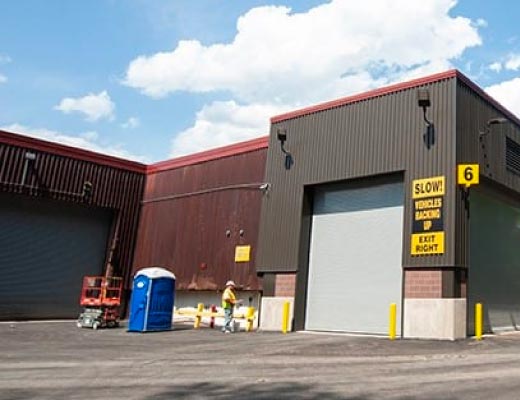Trash in Onondaga County takes a somewhat different journey than trash in most U.S. communities.
Instead of going right to a landfill, most of our community’s trash is sent to the local Waste-to-Energy Facility, where it is turned into enough electricity to power 30,000 households a year. This reduces the amount of material that needs to be landfilled by 90%.
It also allows extraction of metals for recycling, which would otherwise go to a landfill. The facility uses state-of-the-art pollution control technologies, and all emissions are carefully monitored with oversight by the NYS Department of Environmental Conservation. Results of the facility’s annual air emissions and ash residue tests consistently demonstrate the facility’s exemplary environmental track record. Anyone can see real-time data from our Waste-to-Energy Facility that demonstrates its superior environmental performance.
See How Waste-to-Energy Works
Operating under one of the strictest WTE air permits in the country, the Onondaga County WTE Facility turns the County’s non-recyclable trash into energy. Results of the Facility’s annual air emissions and ash residue test results consistently demonstrate the Facility’s exemplary environmental track record.
Environmental Monitoring
Paramount to Facility operations is ensuring that the Facility’s emissions are protective of human health and the environment.
A state-of-the-art air pollution control system is integrated into the Facility so that it may comply with one of the strictest air permits in the nation. Emissions are carefully monitored through a Continuous Emissions Monitoring System (CEMS) and annual air emissions or stack tests.
Annual stack testing is an important tool that measures the amount of regulated pollutants being emitted from the Facility. Stack testing consists of a series of sampling events, in which a probe is inserted into the stack gases to collect a representative sample, over a defined amount of time. Sampling and laboratory analysis are conducted in accordance with NYSDEC and USEPA protocols. NYSDEC oversees stack testing at the WTE Facility.
In addition to annual stack testing, the Facility’s CEMS measures equipment performance and stack emissions in order to constantly track Facility performance. The CEMS tracks:
- carbon monoxide,
- carbon dioxide,
- oxygen,
- sulfur dioxide,
- NOx
- opacity, and
- combustion temperatures.
These parameters are indicators of complete combustion in the boiler and proper functioning of the air pollution control system.
Emissions Data and Reports
OCRRA’s core values – integrity and honesty, environmental stewardship, fiscal responsibility, and excellence-in-service are the foundation for operation of the WTE Facility.
Each year, OCRRA posts detailed annual WTE reports, as well as all of the annual air and ash testing results.
The annual testing and CEMS data have consistently shown that the Facility meets or exceeds all permit requirements. OCRRA and Reworld™ (formerly Covanta), the operator of the Facility, take great pride in the Facility’s strong operational and environmental track record.
Facility Recognition
- 2012 – Solid Waste Association of North America (SWANA) Waste-to-Energy Operations Gold Award
- 2011 – Environmental Business Journal, Project Merit Award
- 2009 – NY Environmental Leaders Program
- 2008 – POWER Magazine Top Renewable Plant
- 2008 – American Society of Mechanical Engineers (ASME) Large Combustion Facility Award
- 2007 – Solid Waste Association of North America (SWANA) Waste-to-Energy Silver Award
- 2007 – USEPA National Environmental Performance Track
- 2006 – Occupational Safety and Health Administration (OSHA) Voluntary Protection Program
- 2000 – Solid Waste Association of North America (SWANA) Waste-to-Energy Gold Award


